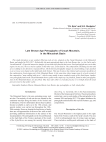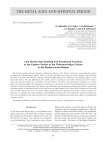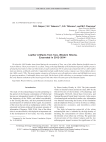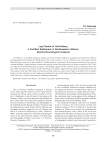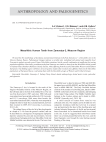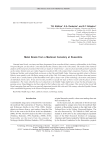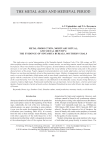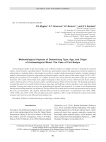The metal ages and medieval period. Рубрика в журнале - Archaeology, Ethnology & Anthropology of Eurasia
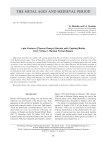
Late Krotovo (Cherno-ozerye) burials with casting molds from Tartas-1, Baraba forest-steppe
Статья
Бесплатно
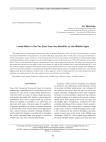
Lobed Ware in the Far East from the Neolithic to the Middle Ages
Статья научная
The study focuses on the origin and survival of the so-called lobed ware in the Far East. The term refers to vessels decorated with shallow vertical grooves, less often with deep, wide dents, either on the most convex part of the body or on the entire surface. Some vessels are covered with groups of vertical carved lines or burnished, less often painted bands imitating lobulation. Such ceramics are especially frequent at sites of the Jurchen era (7th–13th centuries) in the Amur basin. They are also found in Primorye, northeastern China, and in adjacent territories. The study of various sources shows that the lobed ware was made on the Lower Amur as early as the Neolithic (5th to late 2nd millennia BC), with the earliest samples relating to the Kondon culture. Typical lobed ceramics were also made by people of the Malyshevo and Voznesenovskoye cultures. It is hypothesized that the Jurchen-Bohai pottery, including the lobed ware, was directly influenced by Korean traditions of the first two or three quarters of the 1st millennium AD. Given the distinctness of the tradition, its reminiscences in the Amur region can be traced back to the Neolithic.
Бесплатно
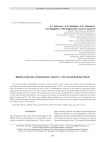
Medieval burials at Ryabchikov Klyuch-1, the Kansk-Rybinsk basin
Статья научная
Previously, burials at Ryabchikov Klyuch-1 on the Kan River near Kansk were dated to the Late Middle Ages (pre-Russian period) and attributed to an autochthonous group. In 2015, two burials were discovered at the cemetery, with the remains of an adolescent girl and a child. A comprehensive analysis of the burial rite and grave goods suggests that the burials date to the 12th century. Numerous archaeological and ethnographic parallels were found. Morphologically, the girl’s cranium reveals generally eastern traits, specifically those common in Western Siberian (Uralic and Ob-Irtysh) populations. The cranium was restored, and a graphical reconstruction of the face was made. Burial practices of the 17th–19th century Middle Kan populations are described. They were Ket-speaking Kotts, Turkic-speaking Karagas, and Samoyed-speaking Kamasins. The analysis of sources suggests that the buried people were likely ancestors of the Kotts.
Бесплатно
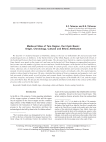
Medieval sites of Tara region, the Irtysh basin: origin, chronology, cultural and ethnic attribution
Статья
Бесплатно
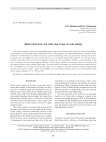
Metal Celts from the Little Sea Coast of Lake Baikal
Статья научная
This article examines metal celts accidentally found 2 km west of Kurma on the Little Sea coast of Lake Baikal, in the foothills of Primorsky Ridge, Olkhonsky District, Irkutsk Region. Detailed information is provided on the conditions in which they were found and aspects of their technology, form, and decoration. The specimens have no eyelets, are rectangular in cross-section, and were cast in bivalve molds. They differ in size and decoration. On their wide sides, there are holes for supports inserted into the mold halves. While no exact parallels to the celts are known, several chronological indicators (body shape, socket cross-section, absence of eyelets, and decoration) point to the Scythian-Tagar stage. The most similar specimens are the Krasnoyarsk-Angara type of celt, distributed over the taiga belt from the Yenisei to the Angara. X-ray spectrometric analysis suggests that the celts were made of “pure” copper. In the Olkhon area, the Scythian-Tagar celts are associated with the Slab Grave culture, dating to 2778–1998 cal BP.
Бесплатно
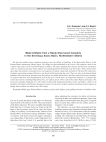
Metal artifacts from a newly discovered cemetery in the Severnaya Sosva basin, Northwestern Siberia
Статья обзорная
Бесплатно
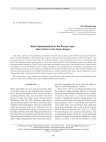
Metal spearheads from the Bronze Age – new finds in the Omsk region
Статья научная
This study addresses the morphological features and chronology of the Seima-Turbino spearheads found by chance in the Omsk Region. Their chronology evidences both general and specific features of their distribution. Late specimens attest to a long period of their use in Western Siberia. Special attention is paid to rare spearheads with Janus-like anthropomorphic representations, whose style reveals parallels with both Okunev tradition and Bronze Age anthropomorphic toreutics of China. In the forest-steppe and southern taiga areas of the Middle Irtysh, Seima-Turbino spearheads co-occur with molds for their casting, testifying to local manufacture or replication. Consequently, even undocumented specimens can reveal the meridionally directed (south to north) trade routes. The abundance and diversity of Bronze Age spearheads from the Middle Irtysh provide yet another demonstration of this region's significance as one of the centers from which Seima-Turbino bronzes spread across southwestern Siberia.
Бесплатно
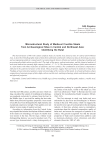
Статья научная
The microstructure of 9th–15th century artifacts made of crucible steel, found at sites in Central and Northwest Asia, is described. Metallographic study of items from settlements and burials with precise data on chronology, location, and accompanying artifacts is important for reconstructing the history of bulat steel and the technology of melting and processing ultra-high-carbon crucible steel. The study of the macro- and microstructure, and the chemical analysis of such items indicate an extremely high content of carbon—1.7–2.1 %. The characteristic feature of their microstructure is a dark matrix with white inclusions of ledeburite and iron carbides. The combination of structural components is reflected in the patterned structure of the metal. These properties suggest that such metal is identical to bulat steel. Findings of macrostructural analysis extend our knowledge of the varieties of this metal, its structural features, phase composition of separate groups of ultra-high-carbon crucible steel, smelting technology, plastic and thermal treatment, and physical properties.
Бесплатно
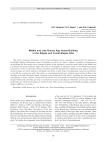
Middle and Late Bronze Age house-building in the steppe and forest-steppe Altai
Статья обзорная
Бесплатно
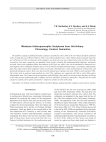
Miniature anthropomorphic sculptures from Ust-Voikary: chronology, context, semantics
Статья научная
We publish a sample of anthropomorphic sculptures unearthed in 2012–2016 at the Ust-Voikary fortified settlement in the circumpolar zone of Western Siberia. This is one of the permafrost sites, where artifacts made of organic materials are well preserved. The vast majority of the sculptures are made of wood, two of sheet metal, and one from a limonite concretion. Four main categories are identified: busts, heads, relatively full anthropomorphic figurines, and masks on sticks. Most of the sculptures follow the tradition of Ob-Ugric art, while a few can be attributed to Samoyedic art. Some figurines have additional elements such as rows of notches and diamond-shaped signs. According to ethnographic data, these signs endowed the sculptures with a sacral status. The finds have a clear archaeological, architectural, and dendrochronological context. Most were discovered in cultural layers dating to the early 1500s to early and mid-1700s. The artistic style is analyzed, and parallels are cited. The sculptures are compared with 18th to early 20th century ethnographic data. The connection of most figurines with dwellings, their small size and style show that they all belong to the ritual wooden anthropomorphic sculpture and were attributes of domestic sanctuaries. They fall into two main categories: family patron spirits and ittarma—temporary abodes of souls of the dead.
Бесплатно
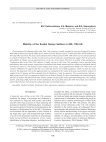
Mobility of the Suzdal Opolye settlers in 900-1150 AD
Статья
The formation of Northeastern Rus in the 10th–11th centuries is usually regarded as a process triggered by intense multicultural interaction and the infl ux of new settlers from the Dnieper region, Northwestern Rus, and Scandinavia to the Volga-Oka watershed. The dense rural settlement network that existed in 1000–1300, which was recently documented in central Northeastern Rus, and the reconstructed medieval landscapes unambiguously suggest that the prosperity and stability of villages was an important factor in the rise of the region. The level of mobility of the population in Northeastern Rus in the 10th–12th centuries is highly relevant to this issue. This parameter can be assessed using paleodietary data on the isotopic composition of strontium in the dental enamel and bone collagen of individuals buried at medieval cemeteries. The analysis of such samples from a large, rural agglomeration dating to the 10th–early 13th centuries, Shekshovo-9, suggests that this was a culturally diverse and wealthy population, which was part of a trade network. The migration level in this agglomeration was estimated by the results of the mass spectrometric analysis of samples from 24 humans and three animals from the Shekshovo-2 and -9 cemeteries. The reconstructions indicate a high proportion of locals as compared to similar sites in Eastern Europe. No direct relationship was found between the presence of artifacts introduced from other cultures and the isotopic profi le of fi rst-generation immigrants. The resulting pattern, indicating a high proportion of native individuals, has no parallels among the 10th–11th century sites in Eastern and Northern Europe represented by comparable data on strontium isotopes.
Бесплатно
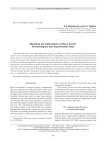
Modeling the deformation of bone points: archaeological and experimental data
Статья обзорная
Бесплатно

